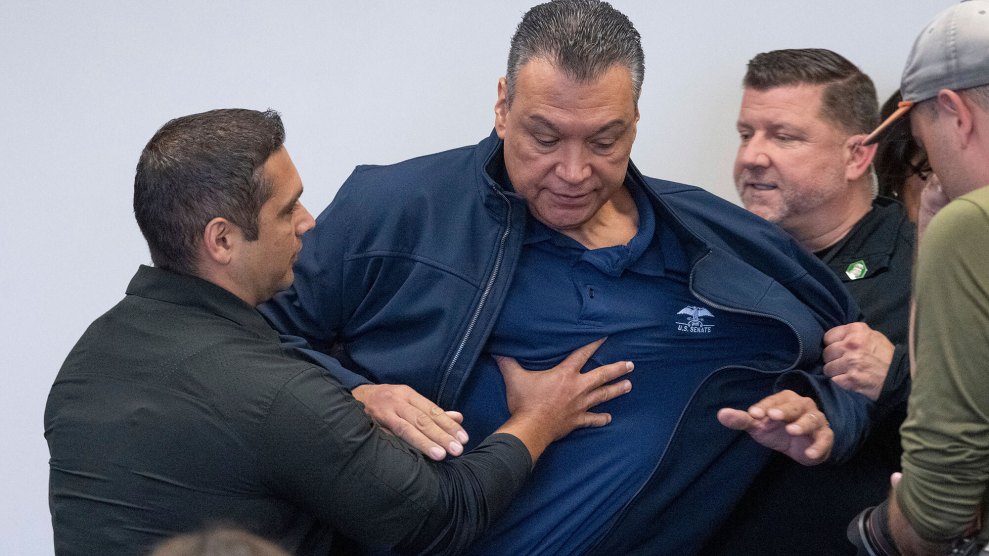A new Homeland Security program monitors visitors to the U.S. by fingerprinting and photographing them, the idea being to nab terrorists and so preempt attacks. Limits in intelligence and technology, though, mean that while the program might catch criminals with prior convictions, it probably won’t be effective at catching and tracking potential terrorists. Critics say the government is more interested in creating a sense that something is being done than in implementing effective programs, on the time-honored rationale of CYA.
The U.S. VISIT program (U.S. Visitor and Immigrant Status Indicator Technology), run by the Department of Homeland Security, requires travelers to the U.S. to be photographed and have two index fingerprints taken by digital scanners. (Citizens of 27 countries, including Australia, Canada, Japan, New Zealand, Singapore and most European nations, are exempted.) The extra security measures allow customs agents to instantly check a visitor’s background for criminal records in an FBI data base.
A pilot program in Atlanta in November proved successful at catching criminals, if not terrorists. Out of 20,000 screened travelers, 21 names matched with those on the FBI watch list.
The program is now being launched at 115 U.S. airports and 14 seaports.
Homeland Security Secretary Tom Ridge said the procedure adds only 15 seconds to a traveler’s security checks and described it as “part of a comprehensive program to make sure our borders remain open to visitors but closed to terrorists.”
Critics of the program wonder about that. The hijackers responsible for 9/11, for instance, would not have been caught under this system. All 19 of the September 11th hijackers entered the U.S. using valid visas, on their own passports. Three of them had overstayed their visas, but the fingerprinting would not catch this sort of offense. A spokesperson from the American Immigration Lawyers Association explains the program’s flaws:
“This gives us the illusion that we’re more secure because we’re compiling all these mountains of information. But, in fact, it does very little to tell you who the dangerous ones are.”
Screening of “biometrics” (human characteristics such as faces, hand shapes, and fingerprints) is expensive, and there are question marks over its effectiveness. The U.S. VISIT program will cost $380 million a year. In their current form, fingerprint analysis machines can be spoofed, some by just blowing on them.
Also, when there is a large database to check, “false matches” (meaning the fingerprint doesn’t correlate with the correct person) are fairly common. U.S. VISIT will require integrating more than 20 databases at the Homeland Security and State departments.
The Economist explains that biometric systems have been in the works for some time, but haven’t been implemented previously because benefits don’t yet justify costs:
“If you are trying to spot members of a small group of known terrorists, even the best of today’s biometric systems produce hundreds of false matches for every correct match with a terrorist. The result is that the system is flooded with false alarms, which are routinely ignored, providing almost no additional security. As a result, the new border-control systems now being implemented at American border posts are merely verification systems.”
Civil liberties advocates worry about the potential for invasion of privacy in the plan. Timothy Edgar, an ACLU Legislative Counsel said:
“The US VISIT program is also a large privacy violation waiting to happen, with records garnered under the program likely retained even after you’ve become a citizen, and a provision permitting their sharing with foreign governments.”
Some countries have already shown a strong aversion to the program, most vehemently Brazil. In an act of retaliation to the U.S. VISIT program, a Brazilian federal judge last month ordered police to begin fingerprinting Americans starting Jan. 1. He called the U.S. system an “absolutely brutal, threatening human rights, violating human dignity, xenophobic.”
Experts in the field of biometrics consider the moves to implement them to be premature, given the imperfections in current technology. But in an era of heightened paranoia, perhaps the goal isn’t to prevent terrorism, but to create the sense that something is being done. Again, The Economist:
“Even John Siedlarz, who co-founded the International Biometrics Industry Association to promote the sale and use of the technology, says that “recent congressional requirements are premature in my view.” Despite this concern from industry experts, politicians are keen to push onwards, and not only in America…It is difficult to avoid the conclusion that the chief motivation for deploying biometrics is not so much to provide security, but to provide the appearance of security.”
















